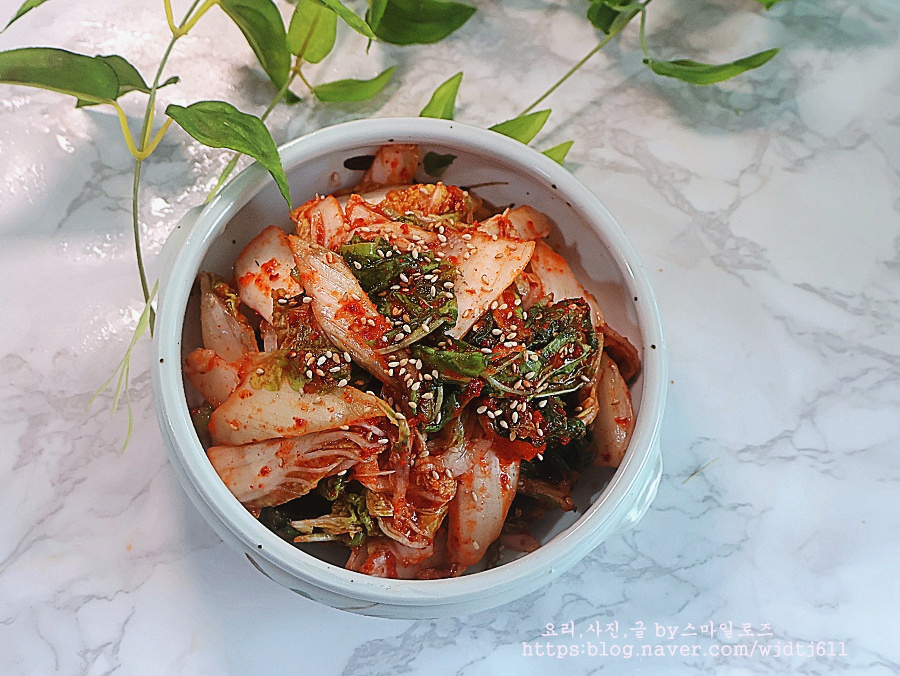Crispy and Savory Spring Cabbage Salad (Bomdong Geotjeori)
How to Make Spring Cabbage Salad, Spring Cabbage Muchim, Spring Cabbage Kimchi Seasoning Recipe

I found some spring cabbage at the discount corner of the supermarket recently, and they were quite good! I couldn’t resist buying two heads, one large and one small, for only 2000 won. Upon bringing them home, I noticed they had more green outer leaves than yellow inner ones. Instead of salting them like regular cabbage for kimchi, I decided to make a fresh salad. I blanched the tougher outer leaves separately and then lightly salted the remaining spring cabbage before mixing everything with a flavorful seasoning. The result was incredibly delicious – savory, crisp, and utterly irresistible, a true rice thief! The most common ways to enjoy spring cabbage are in a fresh salad (geotjeori) or a seasoned dish (muchim). As we’re running low on kimchi from the winter season, this spring cabbage geotjeori serves as a perfect alternative. It’s refreshing and satisfying with its crisp texture and rich, savory flavor that lingers delightfully. Let’s get started on how to make this delightful spring cabbage geotjeori!
Spring Cabbage Geotjeori Ingredients- 1kg spring cabbage, prepared
- 1 stalk green onion
- 4 Tbsp gochugaru (Korean chili flakes)
- 2 Tbsp fish sauce
- 2 Tbsp plum extract (maesilcheong)
- 1 Tbsp toasted sesame seeds
- 0.5 Tbsp kosher salt
Blended Seasoning Ingredients- 1/4 pear
- 1/4 apple
- 1/4 onion
- 0.7 Tbsp grated ginger
- 10 cloves garlic
For Salting the Cabbage- 1/3 cup coarse sea salt
- 1/4 pear
- 1/4 apple
- 1/4 onion
- 0.7 Tbsp grated ginger
- 10 cloves garlic
For Salting the Cabbage- 1/3 cup coarse sea salt
Cooking Instructions
Step 1
Spring cabbage is one of the first vegetables to herald spring, offering a wonderfully crisp texture that’s perfect for fresh salads (geotjeori) or seasoned side dishes (muchim). It’s packed with vitamins and antioxidants, beneficial for anti-aging. This cabbage variety is planted in winter and harvested in spring. Unlike tightly packed regular cabbage, it spreads out and has a milder sweetness. Its high beta-carotene content provides antioxidant benefits, aiding in anti-aging and potentially preventing cancer. It’s also rich in minerals like calcium, potassium, and phosphorus, which help prevent anemia and inhibit cholesterol synthesis in the liver, thus preventing arteriosclerosis. With low calories (23kcal/100g raw, 22kcal/100g blanched) and low protein and fat content, it’s best enjoyed with meat as a wrap or in a side dish to supplement nutrients.

Step 2
The spring cabbage I have today has more green outer leaves than the vibrant yellow inner ones. I’ve also finely chopped the green onion that will be used in the salad.

Step 3
To prepare the spring cabbage, trim off the tough bottom end (the core) with a knife, or gather the leaves together and cut off the base.

Step 4
After removing the base, separate the spring cabbage leaves and wash them thoroughly under running water 5-6 times. Make sure to drain the water well afterward.

Step 5
When making a fresh geotjeori, it’s best not to salt the cabbage beforehand to avoid a raw taste and maintain maximum crispness. However, the spring cabbage I acquired today has many green leaves and is slightly tougher, similar to regular cabbage. Therefore, I’ve sliced the leaves and stems diagonally into bite-sized pieces.

Step 6
Place the cut spring cabbage in a large bowl. Sprinkle coarse sea salt evenly over the cabbage and let it sit for about 20 minutes to wilt slightly. We’re not using as much salt or salting for as long as we would for kimchi; the goal is just to soften the cabbage a bit. Spring cabbage can be eaten without salting, but a light salting enhances its crisp texture.

Step 7
Once the spring cabbage leaves feel slightly tender and pliable, rinse them under cold water and drain them thoroughly in a colander.

Step 8
Prepare the ingredients for blending: peel and core the pear and apple, and chop them along with the onion into pieces that are easy to blend. Peel and mince the ginger, and prepare the garlic cloves.

Step 9
Combine the prepared pear, apple, onion, ginger, and garlic in a blender. Add 2 tablespoons of fish sauce and 2 tablespoons of plum extract, then blend until smooth. Using fruits and vegetables in the seasoning adds natural sweetness and depth of flavor.

Step 10
Add the blended seasoning mixture and gochugaru (Korean chili flakes) to the drained spring cabbage.

Step 11
Gently toss the ingredients to coat the cabbage evenly, being careful not to crush the leaves. Finish by sprinkling toasted sesame seeds for a nutty aroma.

Step 12
Taste the salad and adjust the seasoning. If it needs more saltiness, add about 0.5 tablespoon of kosher salt and mix gently again. This completes the delicious spring cabbage salad! Since I used pear and apple, the sweetness is sufficient, so I didn’t add extra sugar. However, if you prefer a sweeter taste, feel free to add a little sugar. Remember, you can adjust all seasoning quantities to your preference.

Step 13
Transfer the finished spring cabbage salad to a serving dish and sprinkle with more toasted sesame seeds for garnish. I’ve placed the portion for refrigeration directly onto a plate.

Step 14
For an immediate serving, toss the spring cabbage salad with 1 tablespoon of sesame oil and 0.5 tablespoon of sugar. This adds an extra layer of savory flavor and freshness, making the crisp salad incredibly delicious right away.

Step 15
This geotjeori seasoning blend can also be used for other fresh salads, such as lettuce salad. Feel free to adjust the sweetness, saltiness, and sourness to suit your taste for any fresh vegetable salad.



